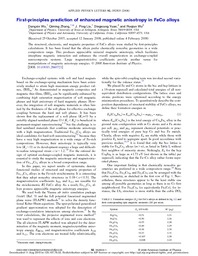
ATTENTION: The works hosted here are being migrated to a new repository that will consolidate resources, improve discoverability, and better show UTA's research impact on the global community. We will update authors as the migration progresses. Please see MavMatrix for more information.
Show simple item record
| dc.contributor.author | Wu, Dangxin | |
| dc.contributor.author | Zhang, Qiming | |
| dc.contributor.author | Liu, J. Ping | |
| dc.contributor.author | Yuan, Dingwang | |
| dc.contributor.author | Wu, Ruqian | |
| dc.date.accessioned | 2010-08-11T16:06:49Z | |
| dc.date.available | 2010-08-11T16:06:49Z | |
| dc.date.issued | 2008-02-04 | en_US |
| dc.identifier.citation | Applied Physics Letters, vol.92, no.5, pp.052503-052503-3, Feb 2008 | en_US |
| dc.identifier.issn | 0003-6951 (print) | |
| dc.identifier.uri | http://hdl.handle.net/10106/5001 | |
| dc.description | Magnetism and Superconductivity Issue | en_US |
| dc.description.abstract | The structural, electronic, and magnetic properties of FeCo alloys were studied by first-principles calculations. It has been found that the alloys prefer chemically noncubic geometries in a wide composition range. This produces appreciable uniaxial magnetic anisotropy, which facilitates interphase magnetic interaction and enhances the overall magnetization in exchange-coupled nanocomposite systems. Large magnetostrictive coefficients provide another venue for manipulations of magnetic anisotropy energies. | en_US |
| dc.language.iso | en_US | en_US |
| dc.publisher | American Institute of Physics | en_US |
| dc.subject | ab initio calculations | en_US |
| dc.subject | Cobalt alloys | en_US |
| dc.subject | Iron alloys | en_US |
| dc.subject | Magnetic anisotropy | en_US |
| dc.subject | Magnetostriction | en_US |
| dc.title | First-principles prediction of enhanced magnetic anisotropy in FeCo alloys | en_US |
| dc.type | Article | en_US |
| dc.publisher.department | Department of Physics, The University of Texas at Arlington | en_US |
| dc.identifier.externalLink | http://link.aip.org/link/APPLAB/v92/i5/p052503/s1 | en_US |
| dc.identifier.externalLinkDescription | External link to the article | en_US |
Files in this item
- Name:
- First-principles prediction of ...
- Size:
- 338.3Kb
- Format:
- PDF
- Description:
- PDF
This item appears in the following Collection(s)
Show simple item record


